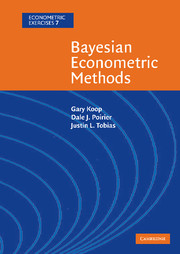Book contents
- Frontmatter
- Contents
- List of exercises
- Preface to the series
- Preface
- 1 The subjective interpretation of probability
- 2 Bayesian inference
- 3 Point estimation
- 4 Frequentist properties of Bayesian estimators
- 5 Interval estimation
- 6 Hypothesis testing
- 7 Prediction
- 8 Choice of prior
- 9 Asymptotic Bayes
- 10 The linear regression model
- 11 Basics of Bayesian computation
- 12 Hierarchical models
- 13 The linear regression model with general covariance matrix
- 14 Latent variable models
- 15 Mixture models
- 16 Bayesian model averaging and selection
- 17 Some stationary time series models
- 18 Some nonstationary time series models
- Appendix
- Bibliography
- Index
17 - Some stationary time series models
Published online by Cambridge University Press: 05 June 2012
- Frontmatter
- Contents
- List of exercises
- Preface to the series
- Preface
- 1 The subjective interpretation of probability
- 2 Bayesian inference
- 3 Point estimation
- 4 Frequentist properties of Bayesian estimators
- 5 Interval estimation
- 6 Hypothesis testing
- 7 Prediction
- 8 Choice of prior
- 9 Asymptotic Bayes
- 10 The linear regression model
- 11 Basics of Bayesian computation
- 12 Hierarchical models
- 13 The linear regression model with general covariance matrix
- 14 Latent variable models
- 15 Mixture models
- 16 Bayesian model averaging and selection
- 17 Some stationary time series models
- 18 Some nonstationary time series models
- Appendix
- Bibliography
- Index
Summary
The field of time series econometrics is an enormous one and it is difficult to do it justice in only a chapter or two. There is a large range of models used with time series data. For univariate time series we have models in the autoregressive moving average (ARMA) class, state space models, models of conditional volatility in the autoregressive conditional heteroscedastic (ARCH) class, and many more. For multivariate time series data, vector autoregressive (VAR) models are the most popular, but many others exist. For both univariate and multivariate specifications there is a growing interest in nonlinear alternatives involving thresholds, regime switching, or structural breaks. In addition, with time series data, new issues arise such as those relating to the presence of nonstationary data (i.e., unit roots and cointegration). In frequentist econometrics, the presence of unit roots and cointegration causes problems since the asymptotic theory underlying, for example, estimators and test statistics, becomes quite complicated. Bayesian econometrics, which conditions upon the observed data, does not run into these problems. However, subtle issues relating to prior elicitation and identification arise when unit root and cointegration issues are relevant. In this chapter and the next, we cannot hope to cover this wide range of models and issues; but rather, we offer a selection of questions to give the reader a flavor for the Bayesian approach to time series methods. In the present chapter, we focus on stationary time series and, thus, do not worry about the complications caused by the presence of nonstationary data.
- Type
- Chapter
- Information
- Bayesian Econometric Methods , pp. 297 - 318Publisher: Cambridge University PressPrint publication year: 2007



